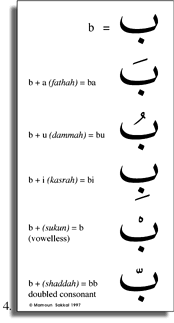Part 2 of 5 articles The Art of Arabic Calligraphy |
|
A Brief History© Mamoun Sakkal 1993 |
|
Islam in Arabic means "submission" and derives from a word meaning "peace," for it is in submitting to God's Will that human beings gain peace in their lives in this world and the hereafter. Islam is a universal message revealed in the sacred book, the Quran, through the Prophet Muhammad, and shares with the other Abrahamic religions, Judaism and Christianity, their ethical teachings and the belief in the One God. Islam is both a religion and a way of life. For Muslims the Quran is the actual Word of God revealed through the archangel Gabrielle to the Prophet of Islam during the twenty-three year period of his prophetic mission. It was revealed in the Arabic language, which became therefore the language of Islam even for non-Arab Muslims. Early calligraphic developments Although early Arabic sources mention several calligraphic styles in reference to the cities in which they were used, they generally fit into two broad categories with some minor variations, these are the "dry styles," the early predecessors of Kufic, and the "moist styles," the early predecessors of the cursive family or scripts. The reform of Arabic script Abul Aswad al Du'ali (d. 688) was the legendary founder of Arabic grammar, and is credited with inventing the system of placing large colored dots to indicate the Tashkeel. It was used with the Kufic scripts, but proved to be somewhat cumbersome to use with smaller scripts, or in ordinary writing. The Ummayad governor al Hajjaj ibn Yusuf al Thaqafi enforced a uniform system
to distinguish letters by using dots, which he asked two of al Du'ali's students
to codify. Development of cursive scripts Under the Ummayads and Abbasids, court requirements for correspondence and record keeping resulted in many developments to the cursive scripts, and several styles were devised to fulfill these needs. Abu Ali Muhammad Ibn Muqlah (d. 940), along with his brother, became accomplished calligraphers in Baghdad in an early age. Abu Ali became a Vizir to three Abbasid caliphs, and is credited with developing the first script to obey strict proportional rules. His system utilized the dot as a measuring unit for line proportions, and a circle with a diameter equals to the Alef's height as a measuring unit for letter proportions (Fig. 5). Ibn Muqlah's system became a powerful tool in the development and standardization of cursive scripts, and his calligraphic work elevated the previous cursive styles into a place of prominence, and made them acceptable as worthy of writing the Quran. Article and figures © copyright 1993 by Mamoun Sakkal |
|
Fig. 4. Al Khalil ibn Ahmad al Farahidi devised a tashkeel system to replace Abu al Aswad's. His system was universally used since the early eleventh century, and included six diacritical marks to indicate the small vowels attached to Arabic letters. |
|
 |
|
Fig. 5. The measuring system of Ibn Muqlah is based on a circle with a diameter that equals the height of the letter Alef. It controls the correct proportions of the letters by comparing them to the circle, and by diagonal dots written with the calligraphy pen. Click on image for details |
|
Part 1 | Part 3 | Part 4 | Part 5 (New)

